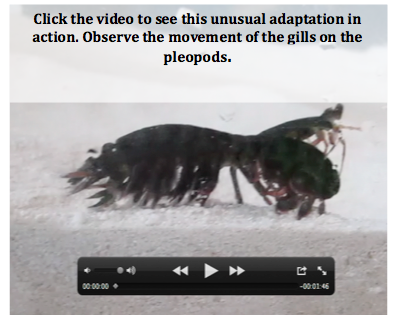RESPIRATORY SYSTEM
Gills on Legs

In Stomatopoda, filamentous gills lie on each of the five pairs of biramous or forked abdominal legs, known as pleopods.
This is an unusual morphological adaptation in a crustacean, however there are other although rare examples of this occurring i.e. in the order Isopoda (Ruppert et al.,2004) and in a burrowing mud shrimp Callianasscaliforniensis, order Decapoda, which dwells in hypoxic conditions (Torres etal., 1977). So, it would seem that Stomatopods, Isopods and isolated species of Decapod exhibit the rare characteristic of abdominal appendages which have been adapted as the site of primary gas exchange (Alexander & Chen, 1989).
It is thought that in Isopoda, for which the bulk of the literature on pleopodal gas exchange has been written, the third 'swimming' pleopods do not have an active role in gas exchange. They do, however cause greater ventiliation surrounding the gills. In contrast to Stomatopods, the 4th and 5th 'non-swimming pleopods' are the primary sites of gas exchange in Isopoda (Alexander & Chem, 1989).
There is a dearth of literature on this physiological adaptation in Stomatopods. However, it raises many questions about phylogenetic relationships between the orders. In addition it raises as well as questions about potential ecological factors which may give rise to such an unusual adaptation.
 
|